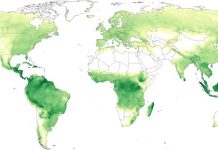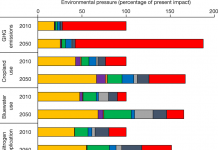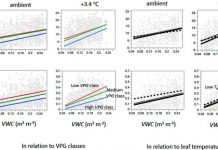【外生菌根真菌与土壤碳循环】Colin Averill* and Christine V. Hawkes. Ectomycorrhizal fungi slow soil carbon cycling. Ecology Letters 2016 DOI: 10.1111-ele.12631
Abstract
Respiration of soil organic carbon is one of the largest fluxes of CO2 on earth. Understanding the processes that regulate soil respiration is critical for predicting future climate. Recent work has suggested that soil carbon respiration may be reduced by competition for nitrogen between symbiotic ectomycorrhizal fungi that associate with plant roots and free-living microbial decomposers which is consistent with increased soil carbon storage in ectomycorrhizal ecosystems globally. However experimental tests of the mycorrhizal competition hypothesis are lacking. Here we show that ectomycorrhizal roots and hyphae decrease soil carbon respiration rates by up to 67% under field conditions in two separate field exclusion experiments and this likely occurs via competition for soil nitrogen an effect larger than 2 °C soil warming. These findings support mycorrhizal competition for nitrogen as an independent driver of soil carbon balance and demonstrate the need to understand microbial community interactions to predict ecosystem feedbacks to global climate.
【深耕与农田土壤有机质】Viridiana Alcántara1 Axel Don1* Reinhard Well1 and Rolf Nieder2. Deep ploughing increases agricultural soil organic matter stocks. Global Change Biology 2016 DOI: 10.1111-gcb.13289
Abstract
Subsoils play an important role within the global C cycle since they have high soil organic carbon (SOC) storage capacity due to generally low SOC concentrations. However measures for enhancing SOC storage commonly focus on topsoils. This study assessed the long-term storage and stability of SOC in topsoils buried in arable subsoils by deep ploughing a globally applied method for breaking up hard pans and improving soil structure to optimize crop growing conditions. One effect of deep ploughing is translocation of SOC formed near the surface into the subsoil with concomitant mixing of SOC-poor subsoil material into the ‘new’ topsoil. Deep-ploughed croplands represent unique long-term in situ incubations of SOC-rich material in subsoils. In this study we sampled five loamy and five sandy soils that were ploughed to 55–90 cm depth 35–50 years ago. Adjacent similarly managed but conventionally ploughed subplots were sampled as reference. The deep-ploughed soils contained on average 42 ± 13% more SOC than the reference subplots. On average 45 years after deep ploughing the ‘new’ topsoil still contained 15% less SOC than the reference topsoil indicating long-term SOC accumulation potential in the topsoil. In vitro incubation experiments on the buried sandy soils revealed 63 ± 6% lower potential SOC mineralisation rates and also 67 ± 2% lower SOC mineralisation per unit SOC in the buried topsoils than in the reference topsoils. Wider C-N ratio in the buried sandy topsoils than in the reference topsoils indicates that deep ploughing preserved SOC. The SOC mineralisation per unit SOC in the buried loamy topsoils was not significantly different from that in the reference







